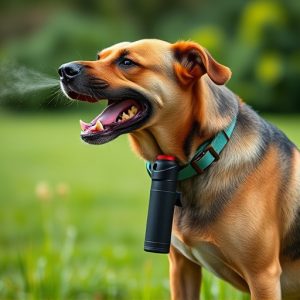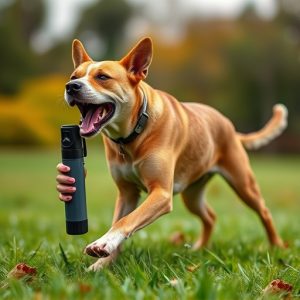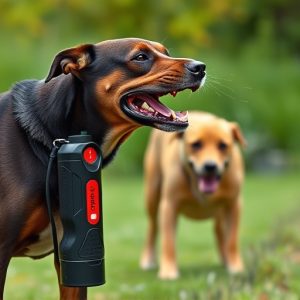Mace Dog Repellent Spray: Effective Use & Alternatives for Aggression Management
Use a Mace Dog Repellent Spray (like those with 10-15ft coverage) as a last resort against dog aggre…….
Use a Mace Dog Repellent Spray (like those with 10-15ft coverage) as a last resort against dog aggression, targeting sensitive areas like eyes and nose within its effective range. Choose products based on surface type, weather conditions, user reviews, certifications, ease of use, and safety features. Maintain canisters responsibly, comply with local laws, and prioritize positive reinforcement training for long-term behavior management to ensure safer interactions between pets and owners.
“Taming aggressive dog behavior can be a challenge, but understanding the right tools can make all the difference. Pepper spray, particularly the Mace Dog Repellent Spray, has emerged as an effective solution for immediate control. This article delves into how this powerful yet non-lethal tool works, guiding you through choosing the ideal mace spray, ensuring safety and optimal coverage during use, and exploring long-term alternatives like training methods to manage dog aggression comprehensively.”
- Understanding Pepper Spray for Dog Aggression: How It Works
- Choosing the Right Mace Dog Repellent Spray: Factors to Consider
- Effective Use and Safety Precautions for Optimal Coverage
- Exploring Alternatives and Training Methods for Long-Term Management
Understanding Pepper Spray for Dog Aggression: How It Works
Pepper spray for dog aggression is a non-lethal deterrent designed to temporarily incapacitate and discourage unwanted behaviors. It works by targeting the canine’s eyes, nose, and respiratory system, causing temporary blindness, irritation, and difficulty breathing. This combination of sensory overload disrupts the dog’s ability to maintain its aggressive stance, allowing you time to safely de-escalate the situation.
The effectiveness of pepper spray relies on proper application and understanding of its range. A Mace Dog Repellent Spray typically has a coverage area of up to 20 feet, giving you space to operate at a safe distance. It’s crucial to remember that while pepper spray can be a powerful tool for dog aggression management, it should be used as a last resort when other training and behavior modification techniques have been exhausted.
Choosing the Right Mace Dog Repellent Spray: Factors to Consider
When selecting a Mace Dog Repellent Spray, understanding its coverage is paramount. Look for products that offer a wide range of protection, suitable for both small and large areas. Consider the spray’s concentration and the distance it can effectively deter an aggressive dog. High-quality mace sprays typically provide a 10-15 foot (3-4.5 meter) barrier, ensuring safety in various scenarios.
Other factors to keep in mind include weather conditions and surface types. Some sprays are designed for optimal performance in specific environments, such as outdoor areas or vehicles. Check for user reviews and product certifications to guarantee both effectiveness and safety. Additionally, consider the ease of use and any additional features that could enhance your experience, like a long-lasting formula or a convenient carrying case.
Effective Use and Safety Precautions for Optimal Coverage
When using Mace Dog Repellent Spray, understanding effective application techniques and safety precautions is vital for optimal coverage and success in deterring aggressive dogs. For best results, aim directly at the dog’s face, specifically the eyes and nose, as this area is highly sensitive. The spray creates a temporary tear gas effect, causing the dog to blink rapidly and experience discomfort, thus encouraging it to back away. It’s important to note that range and wind conditions can affect coverage, so ensure you’re within the recommended distance and consider any environmental factors that might impact the spray’s effectiveness.
Safety should always be a priority when handling pepper spray. Wear protective gear, including gloves and safety goggles, to minimize exposure to the spray. Keep the canister out of reach of children and pets, and store it in a secure location. Understand the expiration date and regular maintenance requirements for optimal performance. Additionally, familiarize yourself with local laws and regulations regarding the use and possession of pepper spray, especially when considering its use around animals.
Exploring Alternatives and Training Methods for Long-Term Management
When considering solutions for aggressive dog behavior, it’s essential to explore alternatives to pepper spray beyond immediate control methods. While mace dog repellent spray can offer a safe and effective deterrent in specific situations, long-term management requires a more holistic approach. Training methods play a crucial role in addressing the root causes of aggression, fostering positive behaviors, and enhancing the overall well-being of both the dog and its owners.
Instead of solely relying on chemical repellents, training can help modify aggressive responses by teaching alternative reactions to triggers. Positive reinforcement techniques, such as rewarding calm behavior or specific commands, can be powerful tools. Desensitization and counter-conditioning methods gradually expose dogs to perceived threats, helping them build confidence and reduce anxiety over time. These approaches not only address the immediate issue of dog aggression but also promote a happier, better-behaved companion for years to come, ensuring a safer and more harmonious coexistence between humans and their canine friends.
In addressing dog aggression, the Mace Dog Repellent Spray offers a powerful yet non-lethal solution, especially during immediate threat scenarios. Understanding its mechanism and choosing the right product is key. Effective use, combined with safety precautions, ensures optimal coverage for deterrence. However, long-term management should encompass alternative methods and training to foster positive behavior changes. By integrating these strategies, individuals can create a safer environment for both dogs and humans alike.


